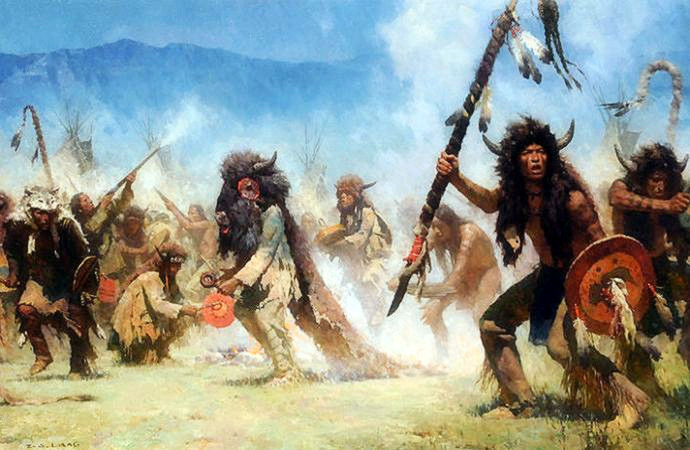In what is now the south western United States
在現(xiàn)在美國的西南部
the Anasazi culture,
阿納薩齊文化
ancestors of the modern Hopi Indians,
霍皮印第安人的祖先
settled down in the 4 corners region around 500BC.
在大約500bc的時(shí)候在4區(qū)交界處定居
They lived in stone and adobe pueblos,
他們住在石制或者土坯房的村落中
often across cliff faces.
通常是穿過懸崖表面
In the Pacific North West,
在西北太平洋沿岸地區(qū)
the tribes of inventively named
發(fā)現(xiàn)的部落被命名為

North Western culture,
西北文化
I like that,
我喜歡這個(gè)名字
North Western culture were known
西北文化以其
for their pot ledge festivals
鍋架節(jié)日著稱
and enjoyed plentiful supplies of food and fish.
擁有豐富的食物和魚資源
They may have lived in villages
他們大概在公元前1000年時(shí)
as early as 1000BC.
在村落中居住
In the Eastern half of the modern United States
在現(xiàn)在美國的東部地區(qū)
a diverse grouping of Indian tribes lived
靠近大海的
in the heavily forested regions
茂密森林中
back from the sea
曾經(jīng)居住過很多不同的印第安人部落
exhibiting equally diverse types of cultures.
他們也有多種多樣的文化
As a general rule Indian cultures
一般來說,印第安文化
across the modern United States
橫跨現(xiàn)在的美國
had a particular reverence for the earth.
對(duì)大地有著特別的敬畏
The earth not only provided them
大地不僅為他們提供了
with their livelihood
謀生之道
whether they were hunters, planters or gatherers
不管他們是獵人,農(nóng)民還是采集者
but it played an important role
同時(shí)還在他們多種多樣的宗教中
in their various religions
扮演了重要的角色
to judge from their surviving myths and legends.
從目前流傳下來的神話傳說來看
To the Indians
對(duì)于印第安人來說
the earth didn't belong to anybody in particular
大地并不屬于某一個(gè)人
but to everyone in common.
而是屬于所有人
This conception was of course completely
這樣的觀點(diǎn)顯然和西歐人的
alien to the western European mind.
完全不同
Neighboring tribes maintain relations
相鄰的部落之間
with each other much as Europeans did,
會(huì)保持聯(lián)系,就像歐洲人一樣
sometimes peaceful, sometimes not.
有的時(shí)候和平共處,有的時(shí)候劍拔弩張
The major difference of course
主要的不同自然是
was that the Europeans came to
歐洲人去美洲時(shí)
the America's bringing guns, horses and alcohol.
帶著槍,馬和酒
Segment 2D;
第四節(jié)
Wave of Exploration early arrivals.
探險(xiǎn)熱潮--早期到來者
The first Europeans known
已知最早來到
to have reached the New World were Norsemen,
新世界的是北歐人
better known to us as Vikings.
我們更熟知的名字是維京人
They were traveling west from Greenland
他們從格陵蘭島向西航行
where Eric the Red had settled around 985AD.
紅頭發(fā)埃里克在985年時(shí)定居在那兒
Eric's son, Leif Ericson
埃里克的兒子,萊夫埃里克森
may have reached the north east coast of
可能是在1000年左右
modern Canada around 1000AD.
到達(dá)了現(xiàn)在加拿大的東海岸
Far to the east,
在遙遠(yuǎn)的東方
in the North West corner of modern Russia,
現(xiàn)在俄羅斯的西北角
Norsemen had already been ruling
北歐人自862年起
the infant Kiev and Russ states since 862AD.
一直在統(tǒng)治著剛剛建立起的基輔和俄國各州
Unlike the later European arrivals to America
不同于后來的歐洲人
who intended to settle down and exploit
希望在美國定居開發(fā)
the Norse were just passing through
北歐人繼承了
in the great Viking tradition,
維京人的傳統(tǒng)
looking for a few cities to sack
只是希望能夠洗劫一些城市
and some farms to pillage
和一些農(nóng)場(chǎng)
and when they got bored they left.
然后他們厭倦之后就會(huì)離開
The Norse oral tradition includes
北歐的口頭文學(xué)中包括
tales of a land called Vineland the Good
名叫好葡萄地的地方
and to this day some still believe that
直到現(xiàn)在還有人認(rèn)為
the Norse voyagers traveled much farther south
北歐人沿大西洋向南航行的距離
along the Atlantic coast
比我們之前認(rèn)為的
than was previously believed.
要遠(yuǎn)的多
The Western Europeans
來到新大陸的
that came to the New World
西歐人
were looking for very specific things.
希望獲得一些特別的東西
They had heard of the gold, slaves
他們已經(jīng)聽說
and other material wealth to be obtained
所謂的"印度人"
in the quote unquote 'Indies'
有黃金,奴隸和別的物質(zhì)財(cái)富
and each nation wanted to get there first.
所有的國家都想第一個(gè)到
They yearned for the eternal glory of
他們渴望得到將異教徒
Christianizing the heathens
轉(zhuǎn)化為基督徒的永恒榮耀
and they yearned for the worldly fame
他們希望獲得最早到達(dá)的
of getting there first.
世界聲譽(yù)
None of these explorers suspected that
沒有一位探險(xiǎn)家想到
another land mass lay
在西歐
between Western Europe
和東亞之間
and Eastern Asia.
還存在一片大陸
The name America itself
美洲這個(gè)名字
comes from the Italian explorer
來自于意大利探險(xiǎn)家
Amerigo Vespucci
阿梅里戈韋斯普奇
whose letters about his trip to the New World
他關(guān)于自己在新大陸旅行的信件
created widespread popular interest.
吸引了全世界的關(guān)注
On the German cartography
德國制圖家
Martin Veldsimeuller's 1507 world map
馬丁·費(fèi)爾德思邁勒1507年繪制的世界地圖中
the New World was named America
將新大陸命名為美洲
in order to honor Vespucci
來向韋斯普奇致敬
even though Martin Veldsimeuller
雖然他很快就
quickly came to regret assigning the name,
后悔這樣做
the names North and South America
北美和南美這兩個(gè)名字
have stuck to this very day.
直到現(xiàn)在還在使用











